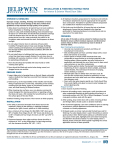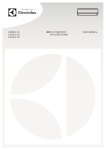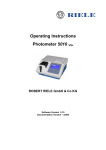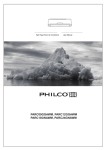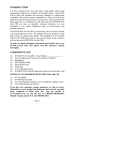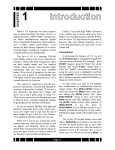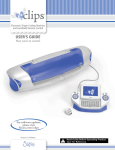Download Section IV - Clutch
Transcript
Section IV CLUTCH SERVICE BULLETIN REFERENCE NUMBER DATE SUBJECT CHANGES 106—CLUTCH CHRYSLER SHOP MANUAL Section IV CLUTCH DATA AND SPECIFICATIONS C-67 Clutch Model Type Facings Inside Diameter Outside Diameter 1376 Single Plate 2 6" 10" 9 Brown 218 at 1 2 % 2 " Length 1962 Lbs. .001" .002" Individual Spring Pressure—Lbs Total Spring Load Crankshaft Flange Face Runout Diameter Runout ESSENTIAL TOOLS C-360 C-585 C-647 C-41 DD-286 C-870 C-435 or C-430 C-730 C-860 Aligning Arbor (Clutch Disc) Compressing Fixture (with No. 44 Spacer) Spring Tester Remover Tool—Pilot Bushing .Installing Tool—Pilot Bushing Fixture—Clutch Housing Aligning Indicator Transmission Pilot Studs Reamer TIGHTENING REFERENCE Part Name Rear Engine Support Insulator Bolts Clutch Housing Cap Screws , Clutch Cover Bolts Transmission to Clutch Housing Cap Screws Torque (Foot-Pounds) 85 35 20 50 CLUTCH—107 CHRYSLER SHOP MANUAL Section IV CLUTCH (C-67 ONLY) 1. GENERAL INFORMATION The clutch is of the single dry disc type, with no adjustment for wear being provided in the clutch itself. An individual adjustment is provided for locating each lever in the manufacturing process and should never be disturbed, unless the clutch is to be removed from the car for repair or overhauling. The only adjustment required while the clutch is in the car, is linkage adjustment to obtain the correct amount of clutch pedal free play. Clutch pedal free play is the movement of the pedal before the clutch starts to engage or disengage. Linkage adjustment is required to restore pedal free play when it has been reduced by normal wear of the clutch. The only service maintenance required is regular periodic lubrication of the clutch (linkage) torque shaft pivot bearings. CAUTION It is very important, when rebuilding or installing a clutch, that the correct clutch disc, pressure plate and springs be installed. Serious vibration, noise or grabbing, chattery clutch will result. (Note the total spring pressure and color of springs.) COVER RELEASE LEVER RELEASE LEVER SPRING ACK (6-SPRINGS) STRUT DISC ASSEMBLY EYEBOLT EYEBOLT NUTS 52x524 Fig. 1—Typical Clutch Assembly (Disassembled View) 108—CLUTCH CHRYSLER SHOP MANUAL SERVICE PROCEDURES 2. REMOVAL AND INSTALLATION OF CLUTCH a. Removal Improper operation or excessive wear may impair the clutch function to the point which may necessitate its removal and overhaul. The clutch can be removed only after the transmission has been removed. To remove the clutch, proceed as follows: (1) Remove the transmission. (2) Remove the clutch housing pan. (3) Pull out the clutch release bearing and sleeve. (4) Mark the clutch cover and flywheel, as shown in Figure 2. Remove the bolts that hold the clutch cover to theflywheel.Loosen each bolt a few turns (in succession) until cover is free. The clutch disc and pressure plate assembly can now be removed from the clutch housing. b. Installation When installing the clutch, observe the following precautions: Fig. 2—Punch Marks on Clutch Cover and Flywheel 1— Clutch cover 2—Punch marks 3—Engine flywheel 4—Balance drilling in engine flywheel Fig. 3—Clutch Disc Aligning Arbor (Tool C-360) (1) Coat the transmission drive pinion pilot bushing (in end of crankshaft) with medium short fiber wheel bearing grease (about a half teaspoonf ul). Place grease in O.D. of cavity at inner end of bushing. (2) Clean the surface of the flywheel and pressure plate thoroughly, making certain that all oil or grease has been removed. (3) Hold the clutch disc, pressure plate and cover in mounting position, with the springs on the disc facing away from the flywheel. Insert a spare transmission drive pinion clutch shaft through hub of disc and into the pilot bushing. If this item is not available, Tool C-360 may be used, as illustrated in Figure 3. (4) Insert the clutch cover attaching bolts (after aligning balance punch marks) but do not tighten. (5) To avoid distortion of the clutch cover, the bolts should be tightened a few turns at a time (alternately) until they are all tight. Tighten the bolts from 15 to 20 foot-pounds torque. Remove Tool C-360 or pinion shaft (if used). CHRYSLER SHOP MANUAL CLUTCH—109 (6) The cover can now be lifted off exposing all parts for cleaning and inspection. NOTE It is important that a notation is made of the location of parts, including the arrangement of the springs. (7) Grasp the lever and eyebolt between the thumb and fingers, as shown in Figure 5, so that inner end of lever and the upper end of eyebolt are close together (keep the eyebolt pin seated in its socket in the lever). Fig. 4—Clutch Cover and Pressure Plate Assembly in Fixture 1 —Clutch cover 2—Clutch pressure plate 3-Fixture (Tool C-585) 4—Punch marks on pressure plate and cover (6) Install the transmission by guiding into position with pilot studs, Tool C-730. Care should be taken not to bend the clutch disc by allowing the transmission to hang. Support the transmission with a suitable jack, then slide into place and secure with bolts. Adjust the clutch pedal free play. 3. SERVICING THE CLUTCH (USING FIXTURE, TOOL C-585) With the clutch cover and pressure plate removed from the car, proceed as follows: a. Disassembly (1) Mark the cover and pressure plate with a prick punch, as shown in Figure 4, so that they may be assembled in their original position to maintain balance. (8) Lift strut over ridge on end of lever and remove lever and eyebolt from the pressure plate. b. Inspection Clean all parts thoroughly using a suitable solvent. Inspect carefully for excessive wear or distortion. c. Pressure Plate If the pressure plate shows signs of scoring, excessive wear, heat checking or warped more than .005 inch, a new pressure plate should be installed. d. Testing Pressure Springs It is advisable to test pressure springs when the clutch is dismantled (after considerable service) or if there has been a great amount of slippage (creating excessive heat) which may have caused the springs to lose their initial pressure. (2) Mount the clutch assembly on compressing fixture, Tool C-585, as shown in Figure 4. (3) Install the three-legged spider over the center screw, so that it rests directly on top of the clutch cover. \ (4) Install the thrust washer and compression nut. Compress assembly by tightening the compression nut. (5) With the assembly under pressure, remove the clutch release lever eyebolt nuts. Release the pressure by unscrewing the compression nut slowly, in order to prevent the springs from flying out. 34x97 Fig. 5—Removing or Installing Clutch Release Lever 110—CLUTCH To test pressure springs, place springs (one at a time) on the seat of Tool C-647, as shown in Figure 6. Attach torque wrench and check pressure (multiply the reading on torque wrench by 2 to obtain correct spring pressure). Discard springs that do not meet minimum requirements. Refer to Data and Specifications. CHRYSLER SHOP MANUAL e. Cover Plate With the other hand, grasp strut between thumb and first finger and insert in slot of pressure plate lug. Drop strut slightly until it touches the vertical milled surface of lug. Insert the lower end of eyebolt into hole in pressure plate, which will bring the short end of lever under the hood of lug and near the strut. Slide the strut upward in slot and lift over ridge and into groove on short end of lever. Check the cover plate for distortion by laying plate on a smooth surface. If the cover shows signs of distortion, install a new cover. Assemble the remaining release levers in the same manner. Continue to assemble, observing the following precautions: f. Release Levers (1) Place the pressure springs on the small bosses on the pressure plate and in the same order of sequence as removed. Replace release levers that are badly worn on the tips (this is an indication of operation with insufficient free play and/or damaged release bearing). Replace eyebolts or adjusting nuts if threads are damaged. Check the struts for wear on the contact edges. Install new parts as required. g. Assembling the Clutch To assemble the clutch, coat the driving lug sides with a thin coat of MOPAR Lubriplate. Assemble the release levers as follows: Assemble the lever pin and eyebolt to the release lever. Holding the threaded end of eyebolt between the thumb and index finger, allow the end of lever to rest on second finger. Keep end of lever and eyebolt as close as possible. NOTE It is very important that the springs be arranged in like sequence in each group in order to retain original balance. (2) Match up the prick punch marks made when disassembling, so that the cover and pressure plate will be assembled in their original relationship. (3) The assembly may be slowly compressed (as outlined for disassembly), making sure that the eyebolts and drive lugs are guided through the holes in the cover. (4) Screw the adjusting nuts on the protruding eyebolts, until the nuts are flush with the top of the eyebolts. Slowly release pressure by unscrewing the compression nut on the tool. Depress each lever several times to settle parts into working position. 4. ADJUSTING THE RELEASE LEVERS (Fig. 7) Mount the clutch assembly on fixture Tool C-585 with the release levers over the feeler gauge in the base of the fixture and proceed as follows: (1) Install the bolts that hold the cover to the fixture and tighten securely. (2) Place the spacer (number 44) on the center screw of the fixture. Fig. 6—Testing Clutch Pressure Springs (3) Install the compression plate on the center screw. Make sure it rests directly against the clutch release levers. CLUTCH—111 CHRYSLER SHOP MANUAL 5. SERVICING TRANSMISSION DRIVE PINION PILOT BUSHING The use of Tool C-41 will facilitate the removal of worn or scored pilot bushings. a. Removal To remove pilot bushing, screw the tapered pilot of Tool C-41 into the bushing allowing pilot to cut its own threads until a solid grip is obtained. Insert puller screw and turn, forcing bushing out of crankshaft. b. Replacement To replace pilot bushing, slide new bushing over the pilot of Tool DD-286 and drive into place with a soft hammer. This causes bushing to tighten up on pilot. Install cup and puller nut and tighten, thereby, removing tool from bushing. This action burnishes the bushing to the exact size and leaves a smooth and lasting finish. Fig. /—Adjusting Clutch Release Levers 1-Feeler blades (part of Tool C-585 2—Compression plate (part of Tool C-585) 3-Spacers (part of Tool C-585) 4—Clutch release lever eye bolt 5—Clutch release lever eye bolt nut 6-Stake here to lock (4) Install the self-aligning washer, flatwasher and compression nut. (5) Tighten the compression nut until the clutch is fully compressed. (6) Adjust the clutch release levers until the feeler gauges have the same slight drag or feel while being pushed in or pulled out. Tighten the nuts to decrease drag and loosen to increase drag, as shown in Figure 7. Lubricate the bushing with about a half teaspoon of short fiber grease. Insert grease in O.D. of cavity at inner end of bushing (not on clutch shaft) as shown in Figure 8. 6. REMOVING OR INSTALLING THE CLUTCH FORK a. Removal Should it become necessary to replace, remove or install the clutch fork, refer to Figure 9 and 10 and proceed as follows: (1) Unhook the clutch release fork pull-back spring. (2) Disconnect the rear end of the clutch fork (7) Recheck the release lever adjustment to make sure each one is adjusted properly. Stake the nuts to hold them in position. (8) Remove clutch from fixture and install in car, as described in Paragraph 2, of this Section. NOTE Before installing the clutch in the car, check the total spring pressure (see Data and Specifications) . Fig. 8—Lubricating Pilot Bushing Hutch pressure plate 2—Flywheel 3—Pilot bushing 112—CLUTCH CHRYSLER SHOP MANUAL BOOT SPRING WASHER CLUTCH PEDAL RELEASE ROD SNAP RING BEARING-2 STUD LOCK WASHER BEARING-2 BRACKET TORQUE SHAFT ASSY. SPRING BRACKET SPRING RELEASE FORK SCREW-3 PIN WASHER COTTER NUT LOCK WASHER-3 ROD END SPRING WASHER 55x21 Fig. 9—Clutch Linkage (Showing Relationship ot Parts) rod from the fork by removing retaining spring and flatwasher. Lift out clevis pin and separate rod from fork. (3) Pry dust cover boot out and away from clutch housing. Slide boot down shank of fork. This will expose the clutch fork pivot and clutch release bearing. (4) Pivot the clutch fork shank end toward front of engine, at the same time exert sufficient pressure to disengage clutch fork spring clip from pivot ball. (5) Slide clutch fork forward and disengage from throw-out bearing spring. Pull out of clutch housing. NOTE It is usually necessary to remove the clutch housing pan before installing the clutch fork. This is done to facilitate correct location of fork on the release bearing sleeve and for proper assembly of fork boot into clutch housing. b. Installation (1) Slide release bearing as far forward as it will go. Slide clutch fork into housing and engage with springs on throw-out bearing. (2) Slightly pull outward on fork and engage with pivot. Push fork inward to allow retaining spring to pass around pivot stud. NOTE Before installing clutch fork, be sure the fork fingers are lubricated with short fibre grease and the pivot indent is lubricated with MOPAR Lubriplate. (3) Slide dust boot over shank of clutch fork and down against clutch housing. Force retaining tangs of boot into housing opening to hold boot in position. (4) Engage rear end of clutch fork rod with fork. Align holes and install clevis pin and flatwasher. Secure with spring retainer. (5) Hook the release fork pull back spring. REINFORCEMENT GASKET BRACKET WASHER LOCKWASHER NUT BEARING BRACKET FORK / SEAL BOLT PAD- 54x581 Fig. 10—Typical Clutch Linkage (Exploded View) 114—CLUTCH CHRYSLER SHOP MANUAL WINDSHIELD INSTRUMENT PANEL CLUTCH OVER-CENTER SPRING STEERING COLUMN PEDAL M O U N T I N G BRACKET EYE BOLT- PEDAL RETURN RUBBER STOP ADJUSTING NUTr DASH PANEL- CLUTCH PEDAL H STEERING COLUMN ACCELERATOR PEDAL-W' v j PEDAL LOCATION PEDAL TRAVEL ACCELERATOR PEDAL TORQUE SHAFT CLUTCH FORK PULL BACK SPRING CLUTCH RELEASE FORK ROD CLUTCH RELEASE FORK FRAME 54x620 Fig. 11—Suspended Clutch Pedal Assembly and Linkage (Brake Pedal Not Shown) CHRYSLER SHOP MANUAL CLUTCH—115 7. REPLACING CLUTCH TORQUE SHAFT PIVOT BUSHINGS (5) Slide the clutch fork rod over pin on lower lever of torque shaft and install spring clip. a. Disassembly (6) Slide one end of the clutch release fork pull back spring in the hole in fork shank, and the other end into bracket on housing. To install new torque shaft bushings, refer to Figures 9 and 10 and proceed as follows: (1) Unhook the clutch release fork pull-back spring from bracket and fork. (2) Remove the spring retainer that holds the clutch fork rod to the torque shaft. Disengage rod from shaft. Swing rod out of way. (3) Remove the spring retainer holding the pedal rod to the torque shaft. Disengage pedal rod from torque shaft lever pin. (4) Remove the bolts that hold the torque shaft bracket to the frame. (These bolts are located up under the front fender behind splash shield). (5) Remove the retaining spring that holds the pivot, bracket and bushings to the torque shaft. Exert sufficient pressure to force bushings out of torque shaft. (6) Pull torque shaft away from pivot on clutch housing. This forces bushings out of torque shaft. Remove torque shaft from under car. Clean all parts in a suitable solvent and blow dry with compressed air. Inspect the pivot balls and bushings for signs of scoring or excessive wear. Install new parts as required. b. Assembly To assemble the torque shaft, refer to Figures 9 and 10 and proceed as follows: (1) Lubricate the pivot bushings with a suitable chassis grease, and slide over the pivot ball attached to the clutch housing. Slide end of torque shaft over the bushings and down into position. (2) Place the two remaining bushings on the pivot ball mounted on the bracket. Slide the free end of the torque shaft over the bushings and down into position. Install the retaining spring. (3) Slide the pivot bracket against the frame side rail and install bolts and lockwashers. Tighten securely. (4) Engage the clutch pedal rod with the torque shaft lever pin and install spring clip. (7) After new bushings have been installed, lubricate thoroughly. Check the clutch pedal for free play (approximately 1" at the pedal pad or % 6 " free movement at the outer end of the clutch fork). 8. ADJUSTING THE OVER-CENTER SPRING The position of the over-center spring is controlled by an adjusting nut and threaded eye, shown in Figure 11. The upper end of the "C" link is attached by the threaded eyebolt to the over-center spring. The lower end of the "C" link is attached by a pivot to the clutch pedal. The over-center spring is attached at the top end by a pin at the upper corner of the pedal mounting bracket. To adjust the over-center spring, refer to Figure 11, and proceed as follows: (1) Remove spring clip that holds the clutch pedal rod to the clutch pedal. (2) Back off the over-center spring adjusting nut until free of "C" link. (3) With the pedal at 7 inches travel position use the fingers, run adjusting nut back up until it just contacts the "C" link. (4) Turn adjusting nut against "C" link 7 full turns. No more! (5) Install clutch pedal rod and secure with spring clip. This adjustment should give from 12 to 15 pounds pressure on clutch pedal when pedal is held down 1 inch from fully released position. 9. CLUTCH PEDAL ADJUSTMENT (FREE MOVEMENT) Adjust the clutch fork rod "in" or "out" as required to secure %6 inch free play of the clutch release fork outer end. This will provide the 1 inch free pedal movement at the pedal pad with a total of 7 inches full pedal travel. 116—CLUTCH CHRYSLER SHOP MANUAL The upper end of the clutch pedal pivots in the lower end of the mounting bracket, on needle bearings. These bearings require no periodic lubrication, however, they should be lubricated with wheel bearing grease if the pedal is removed for any repair function. 10. CLUTCH HOUSING ALIGNMENT When performing adjustments or repairs that involve removing the clutch housing, it will be necessary to align the face of the housing parallel with that of the block, when assembling. To correctly align the clutch housing, proceed as follows: (1) Inspect the housing face where it contacts the cylinder block, for particles of dirt or burrs. Remove burrs with a file and clean both surfaces thoroughly. Install clutch housing. Tighten clutch housing to block bolts just snug enough so the housing can be shifted if necessary by tapping with a mallet. (2) Install the fixture, Tool C-870 to the flywheel attaching bolts, as shown in Figure 12. Install the indicator, Tool C-435 or C-430, as shown in Figure 12. Rotate the crankshaft and check the inside diameter of the housing bore; it should not vary more than .005 inch in one complete revolution of the crankshaft. If alignment is necessary, remove the dowel pins and tap the housing until it comes within the specified tolerance. After obtaining correct alignment, tighten the housing bolts 30 to 35 foot-pounds torque. 55 x561 Fig. 13—Typical Method of Checking Rear Face of Housing (3) Change the position of the dial indicator and check the rear face of the housing, as shown in Figure 13. This tolerance must be within .003 inch. Assuming that all burrs and dirt has been removed as described in step (1), this tolerance will no doubt be within the specified limits. If alignment of the housing was necessary as described in step (2), the dowel pin holes will have to be reamed. Ream with Tool C-860, as shown in Figure 14, for .512 inch (oversize) dowel pins. (4) After reaming the dowel pin holes, install the two dowels in the block from the front end. 49x716 Fig. 12—Typical Method of Attaching Fixture C-870 and Checking Clutch Housing Bore Fig. 14—Reaming Dowel Pin Holes CHRYSLER SHOP MANUAL CLUTCH—117 NOTE Failure to align clutch housing may result in hard shifting of transmission and the possibility of gear disengagement. CAUTION Steam Cleaning the Engine—Immediately after the cleaning operation, start engine and "slip the clutch*' in order to dry off the disc assembly, pressure plate, and/or flywheel. Fig. 15—Installing Shim Between Engine and Clutch Housing (5) If alignment of the face of the housing was necessary, as described in step (3), it will be necessary to place proper thickness of shim stock between the clutch housing and engine as shown in Figure 15. The clutch housing being ventilated, steam vapor condenses and moisture settles on the internal moving parts of clutch mechanism. The facings on the disc will absorb moisture and under the force exerted by the pressure plate, will bond the facings to flywheel and/or, the pressure plate—if the car is allowed to stand for some time before use. If this condition occurs, it will necessitate complete replacement of disc, pressure plate, flywheel and/or, driving plate. SERVICE DIAGNOSIS 11. CHATTERING CLUTCH Remedies: Possible Causes: a. Readjust clutch, as outlined in Adjustments, Paragraph 4, of this Section. a. Improper lever adjustment. b. Oil or grease on facings. c. Worn splines on transmission shaft. d. Binding pressure plate. e. Binding release levers. f. Binding disc hub. g. Glazed facings. h. Unequal contact of pressure plate. i. Bent clutch disc. j . Uneven spring pressures. k. Improper alignment of transmission. 1. Loose facings. m. Scored pressure plate. b. Check for oil leaks at rear main bearing and at transmission pinion shaft bearing. To correct this condition, refer to Engine and Transmission Sections in this manual. Replace disc assembly and clean clutch parts thoroughly. c. Replace worn transmission drive pinion (clutch shaft). Install new disc assembly and adjust clutch. d. Check pressure plate for binding where lug protrudes through cover; coat contact surfaces with a thin coat of MOPAR Lubriplate. Replace worn partg as required. e. Free up binding release levers. Check for worn or damaged threads on eyebolts, adjusting nuts or where binding appears to be present. Check struts for wear on contact edges and, if necessary, replace. 118—CLUTCH f. Replace disc assembly and adjust clutch. g. Replace disc assembly after checking pressure plate,flywheelor driving plate for possible scoring. If parts are badly scored or worn, complete replacement is required. h. Check clearances of release levers, disc for thickness and pressure plate for parallel position againstflywheelor driving plate. i. Replace disc assembly after checking to determine cause of distortion. Examine pressure plate for excessive wear or scoring. Replace if necessary. j . Check springs for pressure, as described in Testing Pressure Springs, Paragraph 3 (d), of this Section. CHRYSLER SHOP MANUAL Possible Causes: a. Adjust clutch as outlined in Adjustments, Paragraph 4, of this Section. b. Replace disc assembly. Check for oil leak at rear main bearing. To replace the oil seal, refer to Engine Section. c. A flywheel or pressure plate, that shows signs of excessive wear, heat or scoring, must be replaced. d. Free up disc hubs. Check pinion shaft for excessive wear or burrs. Check disc assembly for distortion and replace if necessary. 1. Replace disc assembly. Examine pressure plate and flywheel or driving plate for possible scoring and excessive wear. Replace as required. e. Release levers that are badly worn on the tips should be replaced. This is an indication of operation with insufficient free play or damaged release bearing. Worn or damaged threads on eyebolts or adjusting nuts, or where binding appears to be present (which retards free movement) should be corrected. Check struts for wear on contact edges and replace as required. f. Replace disc assembly. Check pressure plate for excessive wear or scoring. Replace parts as required. m. If pressure plate shows signs of scoring, excessive wear, heat checking, of if warped more than .005 inch, plate must be replaced. g. Replace broken or weak springs. To test springs for pressure, refer to Testing Pressure Springs, Paragraph 3 (d) of this Section. 12. GRABBING CLUTCH h. Replace disc assembly. Use Factory Engineered and Inspected Clutch Disc Assembly. Adjust clutch. k. Check clutch housing alignment. Misalignment between transmission and clutch housing may be caused by chips, dirt, buckled gaskets or burrs. Check to determine cause and correct. Possible Causes: a. Improper lever adjustment. b. Oil or grease on facings. c. Worn pressure plate, flywheel or drive plate. d. Clutch disc hub sticking on pinion (clutch) shaft. e. Worn or binding release levers. f. Worn or glazed facings. g. h. i. j. ings, Broken or weak pressure springs. Incorrect disc facings. Improper alignment of transmission. Worn or deteriorated rubber engine mount- k. Engine loose in supports. i. Check clutch housing alignment. Misalignment between transmission and clutch housing may be caused by chips, dirt, buckled gasket or burrs. Check to determine cause and correct. j . Replace worn engine mountings. k. Check engine mountings for loose bolts. Tighten as required to correct this condition. 13. SUPPING CLUTCH Possible Causes: a. Weak or broken pressure springs: b. Worn facings. c. Improper clutch adjustments. d. Oil or grease on facings. e. Warped disc assembly. CLUTCH—119 CHRYSLER SHOP MANUAL f. Warped or scored pressure plate. 14. DRAGGING CLUTCH g. Binding release levers. Possible Causes: h. Improper clutch linkage adjustment. a. Oil or grease on facings. b. Incorrect lever adjustment. Remedies: c. Incorrect pedal adjustment. a. Replace weak or broken springs. To test springs for pressure, refer to Testing Pressure Springs, Paragraph 3 (d) of this Section. d. Dust or dirt in clutch. e. Worn or broken facings. f. Bent clutch disc. NOTE It is advisable to replace pressure springs when clutch is dismantled (after considerable service) or if there has been a great amount of slippage (creating excessive heat), tvhich may have caused the springs to lose initial tension. g. Disc hub binding on pinion shaft. h. Binding pilot bushing. i. Sticking release bearing sleeve. j . Warped pressure plate. k. Improper alignment of transmission. b. Replace disc assembly. Check pressure, plate, flywheel, or clutch driving plate for possible scoring, heat checking or excessive wear. Test pressure springs for loss of pressure. Replace parts as needed. c. Examine disc assembly for excessive wear or a glazed surface, pressure plate for possible scoring or distortion. Test springs for pressure. Replace parts as required. Adjust clutch. d. Replace disc assembly. Check for oil leak at rear main bearing. To replace the oil seal, refer to Engine Section. e. Replace warped or distorted disc assembly after examining pressure plate for possible damage. Test pressure springs for pressure as described in Paragraph 3 (d) of this Section. f. A pressure plate that is badly scored, heat checked or warped more than .020 inch, must be replaced. Test springs for pressure and install new disc assembly. g. Free up release levers where binding appears to be present which retards free movement. Examine struts for excessive wear on contact surfaces. Lubricate all moving parts with MOPAR Lubriplate. Check disc and pressure plate for scoring or heat checking, and test pressure springs for pressure. Replace parts as required. h. Adjust for clutch pedal free play. 1. Clutch facings too thick. Remedies: a. Replace disc assembly. Check for oil leak at rear main bearing. To replace the oil seal, refer to Engine Section. b. Read j ust levers after checking for possible damage. Refer to Paragraph 3, of this Section. c. Readjust pedal as described in Adjustments, Paragraph 8 of this Section. d. Disassemble clutch and clean thoroughly. Examine all parts for excessive wear or scoring. Replace worn or scored parts as required. At reassembly, coat all moving parts with a thin coat of MOPAR Lubriplate. e. Replace disc assembly. Inspect pressure plate for excessive wear or scoring. Test pressure springs for pressure, as described in Paragraph 3, (A) of this Section. f. Replace bent disc assembly after checking to determine cause of distortion. Replace worn or scored parts. g. Free up disc assembly. Check pinion shaft (clutch shaft) for burrs or gummed splines. Replace parts as required to correct this condition. h. Replace pinion shaft (clutch shaft) pilot bushing, as outlined in Paragraph 4 of this Section. 120—CLUTCH i. Free up sticking sleeve and examine mating surfaces for scoring or rough spots. Replace parts as required to correct this condition. j . A pressure plate that is warped more than .005 inch must be replaced. Install new disc assembly. Adjust clutch. k. Check clutch housing alignment. Misalignment between transmission and clutch may be caused by chips, dirt, buckled gasket, or burrs. Determine cause of condition and correct. 1. When replacing the disc assembly, always use Factory Engineered and Inspected Parts. CHRYSLER SHOP MANUAL 16. VIBRATING CLUTCH Possible Causes: a. Improper balance of assembly. b. Improper fitting of pressure plate. c. Pressure spring off center. d. Improper clutch alignment. e. Loose engine mountings. f. Worn transmission main shaft rear bearing. Remedies: 15. SQUEAKING CLUTCH Possible Causes: a. Lack of lubrication in release sleeve. b. Worn release sleeve. c. Dry pilot bushing. d. Pilot bushing turning in crankshaft. e. Worn drive pinion bearing. f. Improper alignment of transmission. g. Dry clutch plate drive lugs. a. Replace disc assembly and pressure plate to correct this condition. b. Check clutch cover for distortion which would interfere with correct operation of pressure plate. Check clutch cover assembly mounting bolts for looseness and tighten if necessary. c. Check springs for alignment on bosses and test for tension. See Paragraph 3 (d) of this Section. d. Replace disc assembly and align with aligning Tool C-360. Readjust clutch. e. Tighten engine mounting bolts as required. Remedies: f. Replace worn transmission main shaft rear bearing. a. Lubricate release sleeve with MOPAR Lubriplate. 17. VIBRATION PERIODS b. Check sleeve land for interference at Oilite part of release bearing. Replace sleeve if necessary. c. Replace pilot bushing as outlined in Servicing Clutch Shaft Pilot Bushing, Paragraph 5 of this Section. d. Replace pilot bushing as indicated above. Possible Causes: a. Loss of friction lag in clutch disc damper because of oil contamination or use of incorrect disc assembly. b. Propeller shaft installed with ends reversed from original assembly. c. Broken or sagging rear springs. e. Replace worn drive pinion bearing after checking bearing retainer for cracks and excessive wear. Examine pilot bushing and if necessary, replace (see c). a. Install new factory engineered clutch disc assembly. f. Check clutch housing alignment. Misalignment between transmission and clutch housing may be caused by chips, dirt, buckled gasket or burrs. Check to determine cause and correct. b. Reverse assembly of prop, shaft to transmission and axle carrier. Or rotate propeller ends 180 degrees relative to transmission and axle flanges. g. Apply MOPAR Lubriplate to drive lugs. Remedies: c. Replace rear springs.

















